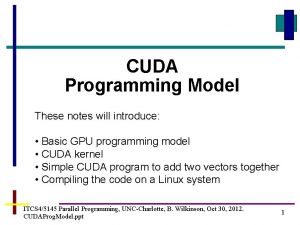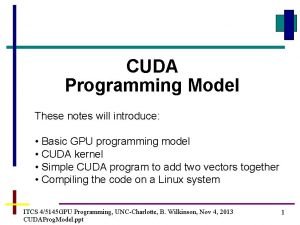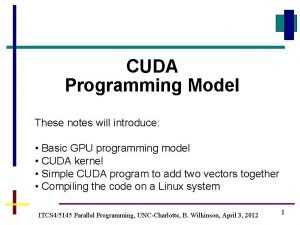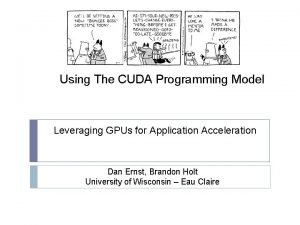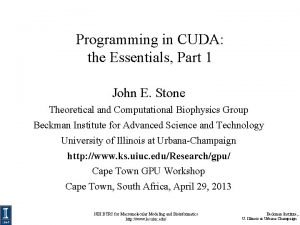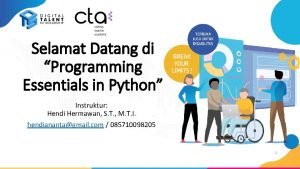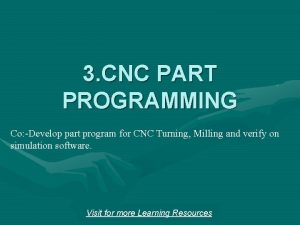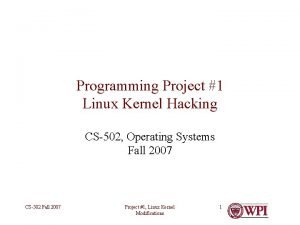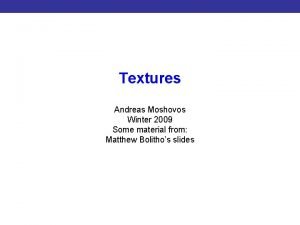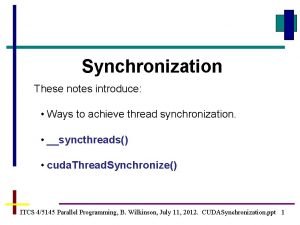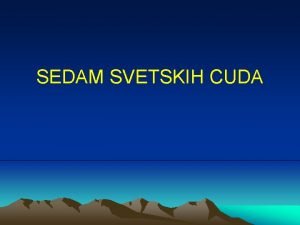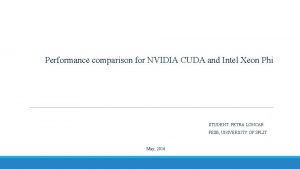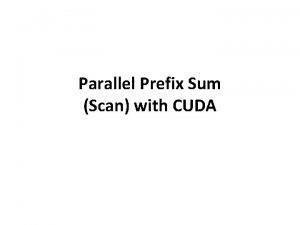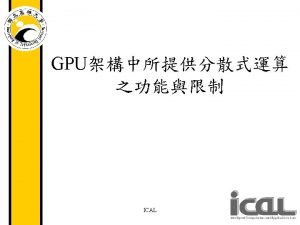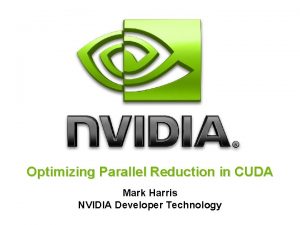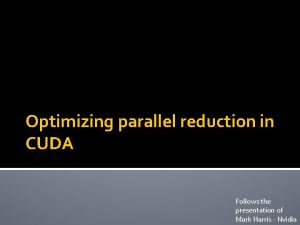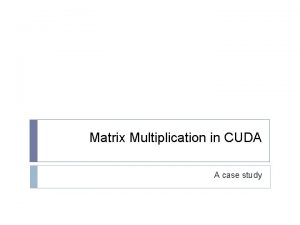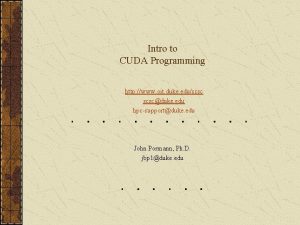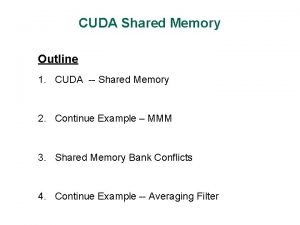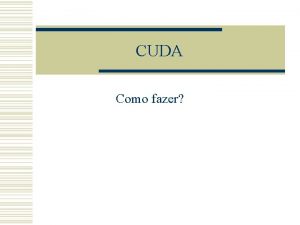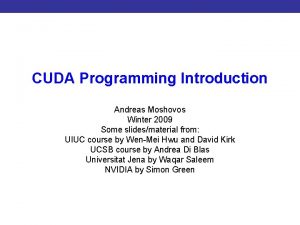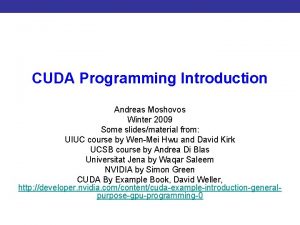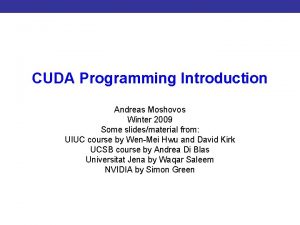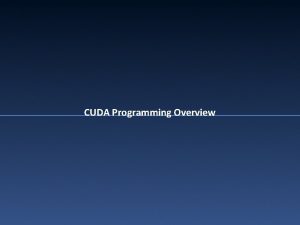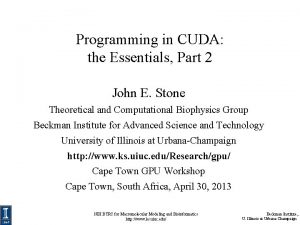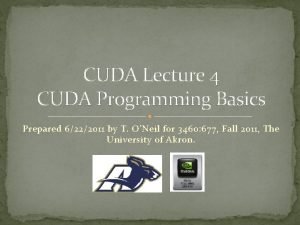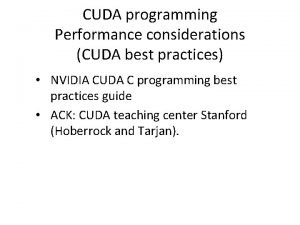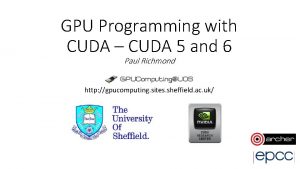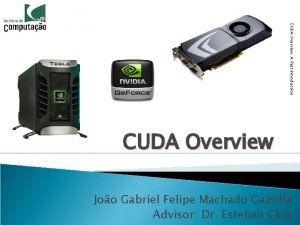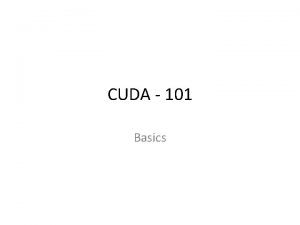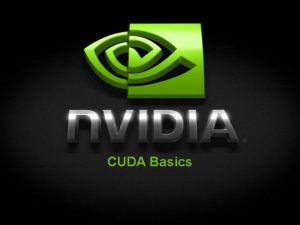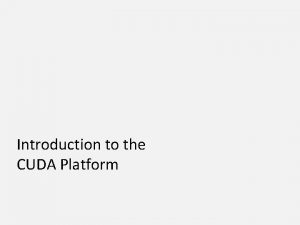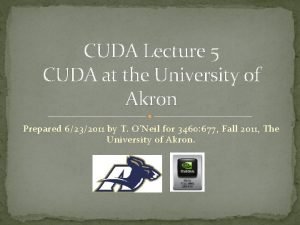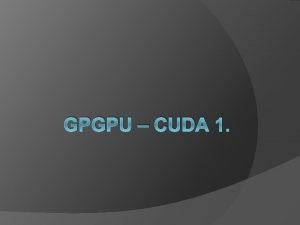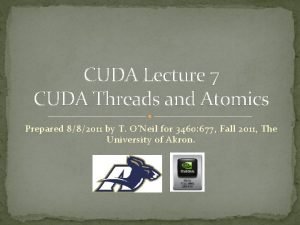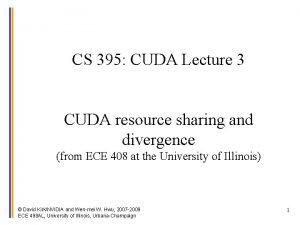Programming in CUDA the Essentials Part 2 John








![Indexing Work • Within a CUDA kernel: – Grid: grid. Dim. [xyz] – Block: Indexing Work • Within a CUDA kernel: – Grid: grid. Dim. [xyz] – Block:](https://slidetodoc.com/presentation_image/85e3be69294ff59522548bff4b98fd4d/image-9.jpg)























![DCS Version 1: Kernel Structure … float curenergy = energygrid[outaddr]; float coorx = gridspacing DCS Version 1: Kernel Structure … float curenergy = energygrid[outaddr]; float coorx = gridspacing](https://slidetodoc.com/presentation_image/85e3be69294ff59522548bff4b98fd4d/image-33.jpg)







![DCS Version 3: Inner Loop …for (v=0; v<8; v++) curenergies[tid + nthr * v] DCS Version 3: Inner Loop …for (v=0; v<8; v++) curenergies[tid + nthr * v]](https://slidetodoc.com/presentation_image/85e3be69294ff59522548bff4b98fd4d/image-41.jpg)











![Shared memory: MDH Kernel (CUDA) extern shared f loat smem [ ] ; int Shared memory: MDH Kernel (CUDA) extern shared f loat smem [ ] ; int](https://slidetodoc.com/presentation_image/85e3be69294ff59522548bff4b98fd4d/image-53.jpg)





















- Slides: 74

Programming in CUDA: the Essentials, Part 2 John E. Stone Theoretical and Computational Biophysics Group Beckman Institute for Advanced Science and Technology University of Illinois at Urbana-Champaign http: //www. ks. uiuc. edu/Research/gpu/ Cape Town GPU Workshop Cape Town, South Africa, April 30, 2013 NIH BTRC for Macromolecular Modeling and Bioinformatics http: //www. ks. uiuc. edu/ Beckman Institute, U. Illinois at Urbana-Champaign

NVIDIA Kepler GPU Streaming Multiprocessor - SMX ~3 -6 GB DRAM Memory w/ ECC GPC GPC 1536 KB Level 2 Cache Graphics Processor Cluster SMX 64 KB Constant Cache 64 KB L 1 Cache / Shared Memory 48 KB Tex + Read-only Data Cache SP SP SP LDST SFU Tex Unit 16 × Execution block = 192 SP, 64 DP, 32 SFU, 32 LDST NIH BTRC for Macromolecular Modeling and Bioinformatics http: //www. ks. uiuc. edu/ Beckman Institute, U. Illinois at Urbana-Champaign

CUDA Work Abstraction • Work is expressed as a multidimensional array of independent work items called “threads” – not the same thing as a CPU thread • CUDA Kernels can be thought of as telling a GPU to compute all iterations of a set of nested loops concurrently • Threads are dynamically scheduled onto hardware according to a hierarchy of thread groupings NIH BTRC for Macromolecular Modeling and Bioinformatics http: //www. ks. uiuc. edu/ Beckman Institute, U. Illinois at Urbana-Champaign

CUDA Work Abstractions: Grids, Thread Blocks, Threads 1 -D, 2 -D, or 3 -D (SM >= 2. x) Grid of thread blocks: Thread blocks are scheduled onto pool of GPU SMs… SM / SMX 1 -D, 2 -D, 3 -D thread block: 0, 0 0, 1 … 1, 0 1, 1 … … NIH BTRC for Macromolecular Modeling and Bioinformatics http: //www. ks. uiuc. edu/ Beckman Institute, U. Illinois at Urbana-Champaign

GPU Thread Block Execution • Thread blocks are decomposed onto hardware in 32 -thread “warps” • Hardware execution is scheduled in units of warps – an SM can execute warps from several thread blocks • Warps run in SIMD-style execution: – All threads execute the same instruction in lock-step – If one thread stalls, the entire warp stalls… – A branch taken by a thread has to be taken by all threads. . . (divergence is bad!) NIH BTRC for Macromolecular Modeling and Bioinformatics http: //www. ks. uiuc. edu/ Thread blocks are multiplexed onto pool of GPU SMs… SM / SMX 1 -D, 2 -D, 3 -D thread block: Beckman Institute, U. Illinois at Urbana-Champaign

GPU Warp Branch Divergence • Branch divergence: when not all threads take Thread blocks are the same branch, the entire warp has to multiplexed onto execute both sides of the branch pool of GPU SMs… • GPU blocks memory writes from disabled threads in the “if then” branch, then inverts all thread enable states and runs the “else” SM / SMX branch • GPU hardware detects warp reconvergence and then runs normally. . . 1 -D, 2 -D, 3 -D • Not unique to GPUs, an attribute of all SIMD thread block: hardware designs… • In the case of the GPU, we are at least benefiting from a completely hardware-based implementation… NIH BTRC for Macromolecular Modeling and Bioinformatics http: //www. ks. uiuc. edu/ Beckman Institute, U. Illinois at Urbana-Champaign

GPU Thread Block Collective Operations • Threads within the same thread block can communicate with each other in fast on-chip shared memory • Once scheduled on an SM, thread blocks run until completion • Because the order of thread block execution is arbitrary and they can’t be stopped, they cannot communicate or synchronize with other thread blocks NIH BTRC for Macromolecular Modeling and Bioinformatics http: //www. ks. uiuc. edu/ Thread blocks are multiplexed onto pool of GPU SMs… SM / SMX 1 -D, 2 -D, 3 -D thread block: Beckman Institute, U. Illinois at Urbana-Champaign

CUDA Grid/Block/Thread Decomposition 1 -D, 2 -D, or 3 -D Computational Domain 1 -D, 2 -D, 3 -D thread block: 1 -D, 2 -D, or 3 -D (SM >= 2. x) Grid of thread blocks: 0, 0 0, 1 … 1, 0 1, 1 … … Padding arrays out to full blocks optimizes global memory performance by guaranteeing memory coalescing NIH BTRC for Macromolecular Modeling and Bioinformatics http: //www. ks. uiuc. edu/ Beckman Institute, U. Illinois at Urbana-Champaign
![Indexing Work Within a CUDA kernel Grid grid Dim xyz Block Indexing Work • Within a CUDA kernel: – Grid: grid. Dim. [xyz] – Block:](https://slidetodoc.com/presentation_image/85e3be69294ff59522548bff4b98fd4d/image-9.jpg)
Indexing Work • Within a CUDA kernel: – Grid: grid. Dim. [xyz] – Block: block. Dim. [xyz] and block. Idx. [xyz] – Thread: thread. Idx. [xyz] • Example CUDA kernel with 1 -D Indexing: __global__ void cuda_add(float *c, float *a, float *b) { int idx = (block. Idx. x * block. Dim. x) + thread. Idx. x; c[idx] = a[idx] + b[idx]; } NIH BTRC for Macromolecular Modeling and Bioinformatics http: //www. ks. uiuc. edu/ Beckman Institute, U. Illinois at Urbana-Champaign

Running a GPU kernel: int sz = N * sizeof(float); … cuda. Malloc((void**) &a_gpu, sz); cuda. Memcpy(a_gpu, a, sz, cuda. Memcpy. Host. To. Device); … // do the same for ‘b_gpu’, allocate ‘c_gpu’ int Bsz = 256; // 1 -D thread block size cuda_add<<<N/Bsz, Bsz>>>(c, a, b); cuda. Device. Synchronize(); // make CPU wait for completion. . . cuda. Memcpy(c, c_gpu, sz, cuda. Memcpy. Device. To. Host); cuda. Free(a_gpu); … // free ‘b_gpu’, and ‘c_gpu’… NIH BTRC for Macromolecular Modeling and Bioinformatics http: //www. ks. uiuc. edu/ Beckman Institute, U. Illinois at Urbana-Champaign

What if Work Size Isn’t an Integer Multiple of the Thread Block Size? • Threads must check if they are “in bounds”: __global__ void cuda_add(float *c, float *a, float *b, int N) { int idx = (block. Idx. x * block. Dim. x) + thread. Idx. x; if (idx < N) { c[idx] = a[idx] + b[idx]; } } NIH BTRC for Macromolecular Modeling and Bioinformatics http: //www. ks. uiuc. edu/ Beckman Institute, U. Illinois at Urbana-Champaign

Direct Coulomb Summation Performance Number of thread blocks modulo number of SMs results in significant performance variation for small workloads CUDA-Unroll 8 clx: fastest GPU kernel, 44 x faster than CPU, 291 GFLOPS on Ge. Force 8800 GTX CPU CUDA-Simple: 14. 8 x faster, 33% of fastest GPU kernel GPU computing. J. Owens, M. Houston, D. Luebke, S. Green, J. Stone, J. Phillips. Proceedings of the IEEE, 96: 879 -899, 2008. NIH BTRC for Macromolecular Modeling and Bioinformatics http: //www. ks. uiuc. edu/ Beckman Institute, U. Illinois at Urbana-Champaign

An Approach to Writing CUDA Kernels • Find an algorithm that can expose substantial parallelism, we’ll ultimately need thousands of independent threads… • Identify appropriate GPU memory or texture subsystems used to store data used by kernel • Are there trade-offs that can be made to exchange computation for more parallelism? – Though counterintuitive, past successes resulted from this strategy – “Brute force” methods that expose significant parallelism do surprisingly well on GPUs • Analyze the real-world use case for the problem and select a specialized kernel for the problem sizes that will be heavily used NIH BTRC for Macromolecular Modeling and Bioinformatics http: //www. ks. uiuc. edu/ Beckman Institute, U. Illinois at Urbana-Champaign

Getting Performance From GPUs • Don’t worry (much) about counting arithmetic operations…at least until you have nothing else left to do • GPUs provide tremendous memory bandwidth, but even so, memory bandwidth often ends up being the performance limiter • Keep/reuse data in registers as long as possible • The main consideration when programming GPUs is accessing memory efficiently, and storing operands in the most appropriate memory system according to data size and access pattern NIH BTRC for Macromolecular Modeling and Bioinformatics http: //www. ks. uiuc. edu/ Beckman Institute, U. Illinois at Urbana-Champaign

Avoid Output Conflicts, Conversion of Scatter to Gather • Many CPU codes contain algorithms that “scatter” outputs to memory, to reduce arithmetic • Scattered output can create bottlenecks for GPU performance due to bank conflicts • On the GPU, it’s often better to do more arithmetic, in exchange for a regularized output pattern, or to convert “scatter” algorithms to “gather” approaches NIH BTRC for Macromolecular Modeling and Bioinformatics http: //www. ks. uiuc. edu/ Beckman Institute, U. Illinois at Urbana-Champaign

Avoid Output Conflicts: Privatization Schemes • Privatization: use of private work areas for workers – Avoid/reduce the need for thread synchronization barriers – Avoid/reduce the need atomic increment/decrement operations during work, use parallel reduction at the end… • By working in separate memory buffers, workers avoid read/modify/write conflicts of various kinds • Huge GPU thread counts make it impractical to privatize data on a per-thread basis, so GPUs must use coarser granularity: warps, thread-blocks • Use of the on-chip shared memory local to each SM can often be considered a form of privatization NIH BTRC for Macromolecular Modeling and Bioinformatics http: //www. ks. uiuc. edu/ Beckman Institute, U. Illinois at Urbana-Champaign

Example: avoiding output conflicts when summing numbers among threads in a block Accumulate sums in threadlocal registers before doing any reduction among threads Parallel reduction: no output conflicts, Log 2(N) barriers += N-way output conflict: Correct results require costly barrier synchronizations or atomic memory operations ON EVERY ADD to prevent threads from overwriting each other… = += += NIH BTRC for Macromolecular Modeling and Bioinformatics http: //www. ks. uiuc. edu/ Beckman Institute, U. Illinois at Urbana-Champaign

Electrostatic Potential Maps • Electrostatic potentials evaluated on 3 -D lattice: • Applications include: – Ion placement for structure building – Time-averaged potentials for simulation – Visualization and analysis Isoleucine t. RNA synthetase NIH BTRC for Macromolecular Modeling and Bioinformatics http: //www. ks. uiuc. edu/ Beckman Institute, U. Illinois at Urbana-Champaign

Overview of Direct Coulomb Summation (DCS) Algorithm • One of several ways to compute the electrostatic potentials on a grid, ideally suited for the GPU • Methods such as multilevel summation can achieve much higher performance at the cost of additional complexity • Begin with DCS for computing electrostatic maps: – conceptually simple algorithm well suited to the GPU – easy to fully explore – requires very little background knowledge, unlike other methods • DCS: for each lattice point, sum potential contributions for all atoms in the simulated structure: potential[j] += atom[i]. charge / rij NIH BTRC for Macromolecular Modeling and Bioinformatics http: //www. ks. uiuc. edu/ Beckman Institute, U. Illinois at Urbana-Champaign

Direct Coulomb Summation (DCS) Algorithm Detail • Each lattice point accumulates electrostatic potential contribution from all atoms: potential[j] += atom[i]. charge / rij Lattice point j being evaluated rij: distance from lattice[j] to atom[i] NIH BTRC for Macromolecular Modeling and Bioinformatics http: //www. ks. uiuc. edu/ Beckman Institute, U. Illinois at Urbana-Champaign

DCS Computational Considerations • Attributes of DCS algorithm for computing electrostatic maps: – Highly data parallel – Starting point for more sophisticated algorithms – Single-precision FP arithmetic is adequate for intended uses – Numerical accuracy can be further improved by compensated summation, spatially ordered summation groupings, or with the use of doubleprecision accumulation – Interesting test case since potential maps are useful for various visualization and analysis tasks • Forms a template for related spatially evaluated function summation algorithms in CUDA NIH BTRC for Macromolecular Modeling and Bioinformatics http: //www. ks. uiuc. edu/ Beckman Institute, U. Illinois at Urbana-Champaign

Single Slice DCS: Simple (Slow) C Version void cenergy(float *energygrid, dim 3 grid, float gridspacing, float z, const float *atoms, int numatoms) { int i, j, n; int atomarrdim = numatoms * 4; for (j=0; j<grid. y; j++) { float y = gridspacing * (float) j; for (i=0; i<grid. x; i++) { float x = gridspacing * (float) i; float energy = 0. 0 f; for (n=0; n<atomarrdim; n+=4) { float dx = x - atoms[n // calculate potential contribution of each atom ]; float dy = y - atoms[n+1]; float dz = z - atoms[n+2]; energy += atoms[n+3] / sqrtf(dx*dx + dy*dy + dz*dz); } energygrid[grid. x*grid. y*k + grid. x*j + i] = energy; } } } NIH BTRC for Macromolecular Modeling and Bioinformatics http: //www. ks. uiuc. edu/ Beckman Institute, U. Illinois at Urbana-Champaign

DCS Algorithm Design Observations • Electrostatic maps used for ion placement require evaluation of ~20 potential lattice points per atom for a typical biological structure • Atom list has the smallest memory footprint, best choice for the inner loop (both CPU and GPU) • Lattice point coordinates are computed on-the-fly • Atom coordinates are made relative to the origin of the potential map, eliminating redundant arithmetic • Arithmetic can be significantly reduced by precalculating and reusing distance components, e. g. create a new array containing X, Q, and dy^2 + dz^2, updated on-the-fly for each row (CPU) • Vectorized CPU versions benefit greatly from SSE instructions NIH BTRC for Macromolecular Modeling and Bioinformatics http: //www. ks. uiuc. edu/ Beckman Institute, U. Illinois at Urbana-Champaign

Direct Coulomb Summation Runtime Lower is better GPU underutilized GPU fully utilized, ~40 x faster than CPU Ge. Force 8800 GTX GPU initialization time: ~110 ms Accelerating molecular modeling applications with graphics processors. J. Stone, J. Phillips, P. Freddolino, D. Hardy, L. Trabuco, K. Schulten. J. Comp. Chem. , 28: 2618 -2640, 2007. NIH BTRC for Macromolecular Modeling and Bioinformatics http: //www. ks. uiuc. edu/ Beckman Institute, U. Illinois at Urbana-Champaign

DCS Observations for GPU Implementation • Naive implementation has a low ratio of FP arithmetic operations to memory transactions (at least for a GPU…) • The innermost loop will consume operands VERY quickly • Since atoms are read-only, they are ideal candidates for texture memory or constant memory • GPU implementations must access constant memory efficiently, avoid shared memory bank conflicts, coalesce global memory accesses, and overlap arithmetic with global memory latency • Map is padded out to a multiple of the thread block size: – Eliminates conditional handling at the edges, thus also eliminating the possibility of branch divergence – Assists with memory coalescing NIH BTRC for Macromolecular Modeling and Bioinformatics http: //www. ks. uiuc. edu/ Beckman Institute, U. Illinois at Urbana-Champaign

CUDA DCS Implementation Overview • Allocate and initialize potential map memory on host CPU • Allocate potential map slice buffer on GPU • Preprocess atom coordinates and charges • Loop over slices: – Copy slice from host to GPU – Loop over groups of atoms until done: • Copy atom data to GPU • Run CUDA Kernel on atoms and slice resident on GPU accumulating new potential contributions into slice – Copy slice from GPU back to host • Free resources NIH BTRC for Macromolecular Modeling and Bioinformatics http: //www. ks. uiuc. edu/ Beckman Institute, U. Illinois at Urbana-Champaign

Direct Coulomb Summation on the GPU Host Atomic Coordinates Charges Grid of thread blocks Lattice padding Thread blocks: 64 -256 threads Constant Memory Threads compute up to 8 potentials, skipping by half-warps Parallel Data Cache Texture Parallel Data Cache Texture GPU Parallel Data Cache Texture Global Memory NIH BTRC for Macromolecular Modeling and Bioinformatics http: //www. ks. uiuc. edu/ Beckman Institute, U. Illinois at Urbana-Champaign

DCS CUDA Block/Grid Decomposition (non-unrolled) Grid of thread blocks: Thread blocks: 64 -256 threads Threads compute 1 potential each 0, 0 0, 1 … 1, 0 1, 1 … … Padding waste NIH BTRC for Macromolecular Modeling and Bioinformatics http: //www. ks. uiuc. edu/ Beckman Institute, U. Illinois at Urbana-Champaign

DCS CUDA Block/Grid Decomposition (non-unrolled) • 16 x 16 CUDA thread blocks are a nice starting size with a satisfactory number of threads • Small enough that there’s not much waste due to padding at the edges NIH BTRC for Macromolecular Modeling and Bioinformatics http: //www. ks. uiuc. edu/ Beckman Institute, U. Illinois at Urbana-Champaign

Notes on Benchmarking CUDA Kernels: Initialization Overhead • When a host thread initially binds to a CUDA context, there is a small (~100 ms) delay during the first CUDA runtime call that touches state on the device • The first time each CUDA kernel is executed, there’s a small delay while the driver compiles the deviceindependent PTX intermediate code for the physical device associated with the current context • In most real codes, these sources of one-time initialization overhead would occur at application startup and should not be a significant factor. • The exception to this is that newly-created host threads incur overhead when they bind to their device, so it’s best to re-use existing host threads than to generate them repeatedly NIH BTRC for Macromolecular Modeling and Bioinformatics http: //www. ks. uiuc. edu/ Beckman Institute, U. Illinois at Urbana-Champaign

Notes on Benchmarking CUDA Kernels: Power Management, Async Operations • Modern GPUs (and of course CPUs) incorporate power management hardware that reduces clock rates and/or powers down functional units when idle • In order to benchmark peak performance of CUDA kernels, both the GPU(s) and CPU(s) must be awoken from their respective low-power modes • In order to get accurate and repeatable timings, do a “warm up” pass prior to running benchmark timings on your kernel and any associated I/O • Call cuda. Thread. Synchronize() prior to stopping timers to verify that any outstanding kernels and I/Os have completed NIH BTRC for Macromolecular Modeling and Bioinformatics http: //www. ks. uiuc. edu/ Beckman Institute, U. Illinois at Urbana-Champaign

DCS Version 1: Const+Precalc 187 GFLOPS, 18. 6 Billion Atom Evals/Sec (Ge. Force 8800 GTX) • Pros: – Pre-compute dz^2 for entire slice – Inner loop over read-only atoms, const memory ideal – If all threads read the same const data at the same time, performance is similar to reading a register • Cons: – Const memory only holds ~4000 atom coordinates and charges – Potential summation must be done in multiple kernel invocations per slice, with const atom data updated for each invocation – Host must shuffle data in/out for each pass NIH BTRC for Macromolecular Modeling and Bioinformatics http: //www. ks. uiuc. edu/ Beckman Institute, U. Illinois at Urbana-Champaign
![DCS Version 1 Kernel Structure float curenergy energygridoutaddr float coorx gridspacing DCS Version 1: Kernel Structure … float curenergy = energygrid[outaddr]; float coorx = gridspacing](https://slidetodoc.com/presentation_image/85e3be69294ff59522548bff4b98fd4d/image-33.jpg)
DCS Version 1: Kernel Structure … float curenergy = energygrid[outaddr]; float coorx = gridspacing * xindex; Start global memory reads early. Kernel hides some of its own latency. float coory = gridspacing * yindex; int atomid; float energyval=0. 0 f; for (atomid=0; atomid<numatoms; atomid++) { float dx = coorx - atominfo[atomid]. x; float dy = coory - atominfo[atomid]. y; energyval += atominfo[atomid]. w * rsqrtf(dx*dx + dy*dy + atominfo[atomid]. z); } energygrid[outaddr] = curenergy + energyval; NIH BTRC for Macromolecular Modeling and Bioinformatics http: //www. ks. uiuc. edu/ Only dependency on global memory read is at the end of the kernel… Beckman Institute, U. Illinois at Urbana-Champaign

DCS CUDA Block/Grid Decomposition (unrolled) • Reuse atom data and partial distance components multiple times • Use “unroll and jam” to unroll the outer loop into the inner loop • Uses more registers, but increases arithmetic intensity significantly • Kernels that unroll the inner loop calculate more than one lattice point per thread result in larger computational tiles: – Thread count per block must be decreased to reduce computational tile size as unrolling is increased – Otherwise, tile size gets bigger as threads do more than one lattice point evaluation, resulting on a significant increase in padding and wasted computations at edges NIH BTRC for Macromolecular Modeling and Bioinformatics http: //www. ks. uiuc. edu/ Beckman Institute, U. Illinois at Urbana-Champaign

DCS CUDA Algorithm: Unrolling Loops • Add each atom’s contribution to several lattice points at a time, distances only differ in one component: potential[j ] += atom[i]. charge / rij potential[j+1] += atom[i]. charge / ri(j+1) … Distances to Atom[i] NIH BTRC for Macromolecular Modeling and Bioinformatics http: //www. ks. uiuc. edu/ Beckman Institute, U. Illinois at Urbana-Champaign

DCS CUDA Block/Grid Decomposition Unrolling increases computational tile size (unrolled) Grid of thread blocks: Thread blocks: 64 -256 threads Threads compute up to 8 potentials 0, 0 0, 1 … 1, 0 1, 1 … … Padding waste NIH BTRC for Macromolecular Modeling and Bioinformatics http: //www. ks. uiuc. edu/ Beckman Institute, U. Illinois at Urbana-Champaign

DCS Version 2: Const+Precalc+Loop Unrolling 259 GFLOPS, 33. 4 Billion Atom Evals/Sec • Pros: (Ge. Force 8800 GTX) – Although const memory is very fast, loading values into registers costs instruction slots – We can reduce the number of loads by reusing atom coordinate values for multiple voxels, by storing in regs – By unrolling the X loop by 4, we can compute dy^2+dz^2 once and use it multiple times, much like the CPU version of the code does • Cons: – Compiler won’t do this type of unrolling for us (yet) – Uses more registers, one of several finite resources – Increases effective tile size, or decreases thread count in a block, though not a problem at this level NIH BTRC for Macromolecular Modeling and Bioinformatics http: //www. ks. uiuc. edu/ Beckman Institute, U. Illinois at Urbana-Champaign

DCS Version 2: Inner Loop …for (atomid=0; atomid<numatoms; atomid++) { float dy = coory - atominfo[atomid]. y; float dysqpdzsq = (dy * dy) + atominfo[atomid]. z; float x = atominfo[atomid]. x; Compared to non-unrolled float dx 1 = coorx 1 - x; kernel: memory loads are decreased by 4 x, and FLOPS float dx 2 = coorx 2 - x; per evaluation are reduced, but float dx 3 = coorx 3 - x; register use is increased… float dx 4 = coorx 4 - x; float charge = atominfo[atomid]. w; energyvalx 1 += charge * rsqrtf(dx 1*dx 1 + dysqpdzsq); energyvalx 2 += charge * rsqrtf(dx 2*dx 2 + dysqpdzsq); energyvalx 3 += charge * rsqrtf(dx 3*dx 3 + dysqpdzsq); energyvalx 4 += charge * rsqrtf(dx 4*dx 4 + dysqpdzsq); } NIH BTRC for Macromolecular Modeling and Bioinformatics http: //www. ks. uiuc. edu/ Beckman Institute, U. Illinois at Urbana-Champaign

DCS Version 3: Const+Shared+Loop Unrolling+Precalc 268 GFLOPS, 36. 4 Billion Atom Evals/Sec • Pros: – Loading prior potential values from global memory into shared memory frees up several registers, so we can afford to unroll by 8 instead of 4 – Using fewer registers allows co-scheduling of more blocks, increasing GPU “occupancy” • Cons: – Bumping against hardware limits (uses all const memory, most shared memory, and a largish number of registers) NIH BTRC for Macromolecular Modeling and Bioinformatics http: //www. ks. uiuc. edu/ Beckman Institute, U. Illinois at Urbana-Champaign

DCS Version 3: Kernel Structure • Loads 8 potential map lattice points from global memory at startup, and immediately stores them into shared memory before going into inner loop. We would otherwise consume too many registers and lose performance (on Ge. Force 8800 at least…) • Processes 8 lattice points at a time in the inner loop • Additional performance gains are achievable by coalescing global memory reads at start/end NIH BTRC for Macromolecular Modeling and Bioinformatics http: //www. ks. uiuc. edu/ Beckman Institute, U. Illinois at Urbana-Champaign
![DCS Version 3 Inner Loop for v0 v8 v curenergiestid nthr v DCS Version 3: Inner Loop …for (v=0; v<8; v++) curenergies[tid + nthr * v]](https://slidetodoc.com/presentation_image/85e3be69294ff59522548bff4b98fd4d/image-41.jpg)
DCS Version 3: Inner Loop …for (v=0; v<8; v++) curenergies[tid + nthr * v] = energygrid[outaddr + v]; float coorx = gridspacing * xindex; float coory = gridspacing * yindex; float energyvalx 1=0. 0 f; [……. ] float energyvalx 8=0. 0 f; for (atomid=0; atomid<numatoms; atomid++) { float dy = coory - atominfo[atomid]. y; float dysqpdzsq = (dy * dy) + atominfo[atomid]. z; float dx = coorx - atominfo[atomid]. x; energyvalx 1 += atominfo[atomid]. w * rsqrtf(dx*dx + dysqpdzsq); dx += gridspacing; […] energyvalx 8 += atominfo[atomid]. w * rsqrtf(dx*dx + dysqpdzsq); } __syncthreads(); // guarantee that shared memory values are ready for reading by all threads energygrid[outaddr ] = energyvalx 1 + curenergies[tid ]; […] energygrid[outaddr + 7] = energyvalx 2 + curenergies[tid + nthr * 7]; NIH BTRC for Macromolecular Modeling and Bioinformatics http: //www. ks. uiuc. edu/ Beckman Institute, U. Illinois at Urbana-Champaign

DCS Version 4: Const+Loop Unrolling+Coalescing 291. 5 GFLOPS, 39. 5 Billion Atom Evals/Sec • Pros: – Simplified structure compared to version 3, no use of shared memory, register pressure kept at bay by doing global memory operations only at the end of the kernel – Using fewer registers allows co-scheduling of more blocks, increasing GPU “occupancy” – Doesn’t have as strict of a thread block dimension requirement as version 3, computational tile size can be smaller • Cons: – The computation tile size is still large, so small potential maps don’t perform as well as large ones NIH BTRC for Macromolecular Modeling and Bioinformatics http: //www. ks. uiuc. edu/ Beckman Institute, U. Illinois at Urbana-Champaign

DCS Version 4: Kernel Structure • Processes 8 lattice points at a time in the inner loop • Subsequent lattice points computed by each thread are offset by a half-warp to guarantee coalesced memory accesses • Loads and increments 8 potential map lattice points from global memory at completion of of the summation, avoiding register consumption NIH BTRC for Macromolecular Modeling and Bioinformatics http: //www. ks. uiuc. edu/ Beckman Institute, U. Illinois at Urbana-Champaign

DCS Version 4: Inner Loop …float coory = gridspacing * yindex; float coorx = gridspacing * xindex; float gridspacing_coalesce = gridspacing * BLOCKSIZEX; int atomid; Points spaced for memory coalescing for (atomid=0; atomid<numatoms; atomid++) { float dy = coory - atominfo[atomid]. y; float dyz 2 = (dy * dy) + atominfo[atomid]. z; Reuse partial distance components dy^2 + dz^2 float dx 1 = coorx - atominfo[atomid]. x; […] float dx 8 = dx 7 + gridspacing_coalesce; energyvalx 1 += atominfo[atomid]. w * rsqrtf(dx 1*dx 1 + dyz 2); […] energyvalx 8 += atominfo[atomid]. w * rsqrtf(dx 8*dx 8 + dyz 2); } energygrid[outaddr ] += energyvalx 1; Global memory ops occur only at the end of the kernel, decreases register use [. . . ] energygrid[outaddr+7*BLOCKSIZEX] += energyvalx 7; NIH BTRC for Macromolecular Modeling and Bioinformatics http: //www. ks. uiuc. edu/ Beckman Institute, U. Illinois at Urbana-Champaign

DCS CUDA Block/Grid Decomposition Unrolling increases computational tile size (unrolled, coalesced) Grid of thread blocks: Thread blocks: 64 -256 threads Threads compute up to 8 potentials, skipping by half-warps 0, 0 0, 1 … 1, 0 1, 1 … … Padding waste NIH BTRC for Macromolecular Modeling and Bioinformatics http: //www. ks. uiuc. edu/ Beckman Institute, U. Illinois at Urbana-Champaign

Direct Coulomb Summation Performance Number of thread blocks modulo number of SMs results in significant performance variation for small workloads CUDA-Unroll 8 clx: fastest GPU kernel, 44 x faster than CPU, 291 GFLOPS on Ge. Force 8800 GTX CPU CUDA-Simple: 14. 8 x faster, 33% of fastest GPU kernel GPU computing. J. Owens, M. Houston, D. Luebke, S. Green, J. Stone, J. Phillips. Proceedings of the IEEE, 96: 879 -899, 2008. NIH BTRC for Macromolecular Modeling and Bioinformatics http: //www. ks. uiuc. edu/ Beckman Institute, U. Illinois at Urbana-Champaign

Multi-GPU DCS Potential Map Calculation • Both CPU and GPU versions of the code are easily parallelized by decomposing the 3 -D potential map into slices, and computing them concurrently • Potential maps often have 50 -500 slices in the Z direction, so plenty of coarse grain parallelism is still available via the DCS algorithm NIH BTRC for Macromolecular Modeling and Bioinformatics http: //www. ks. uiuc. edu/ Beckman Institute, U. Illinois at Urbana-Champaign

Multi-GPU DCS Algorithm: • One host thread is created for each CUDA GPU, attached according to host thread ID: – First CUDA call binds that thread’s CUDA context to that GPU for life • Map slices are decomposed cyclically onto the available GPUs • Map slices are usually larger than the host memory page size, so false sharing and related effects are not a problem for this application NIH BTRC for Macromolecular Modeling and Bioinformatics http: //www. ks. uiuc. edu/ Beckman Institute, U. Illinois at Urbana-Champaign

Multi-GPU Direct Coulomb Summation (Ge. Force 8800 GTX) • Effective memory bandwidth scales with the number of GPUs utilized • PCIe bus bandwidth not a bottleneck for this algorithm • 117 billion evals/sec • 863 GFLOPS • 131 x speedup vs. CPU core • Power: 700 watts during benchmark Quad-core Intel QX 6700 Three NVIDIA Ge. Force 8800 GTX NIH BTRC for Macromolecular Modeling and Bioinformatics http: //www. ks. uiuc. edu/ Beckman Institute, U. Illinois at Urbana-Champaign

Multi-GPU Direct Coulomb Summation NCSA GPU Cluster http: //www. ncsa. uiuc. edu/Projects/GPUcluster/ Evals/sec GPU 1 … GPU N TFLOPS Speedup* 4 -GPU (2 Quadroplex) Opteron node at NCSA 157 billion 1. 16 176 4 -GPU GTX 280 (GT 200) 241 billion 1. 78 271 *Speedups relative to Intel QX 6700 CPU core w/ SSE NIH BTRC for Macromolecular Modeling and Bioinformatics http: //www. ks. uiuc. edu/ Beckman Institute, U. Illinois at Urbana-Champaign

Multi-GPU DCS Performance: Initial Ion Placement Lattice Calculation • Original virus DCS ion placement ran for 110 CPUhours on SGI Altix Itanium 2 • Same calculation now takes 1. 35 GPU-hours • 27 minutes (wall clock) if three GPUs are used concurrently • CUDA Initial ion placement lattice calculation performance: – 82 times faster for virus (STMV) structure – 110 times faster for ribosome • Three GPUs give performance equivalent to ~330 SGI Altix CPUs for the ribosome case Satellite Tobacco Mosaic Virus (STMV) Ion Placement NIH BTRC for Macromolecular Modeling and Bioinformatics http: //www. ks. uiuc. edu/ Beckman Institute, U. Illinois at Urbana-Champaign

Brief Shared Memory Example: Multiple Debye-Hückel Electrostatics • Part of Poisson-Boltzmann solver in the popular APBS electrostatics solver package • Method: compute electrostatic potentials at grid points on boundary faces of box containing molecule • Screening function: NIH BTRC for Macromolecular Modeling and Bioinformatics http: //www. ks. uiuc. edu/ Beckman Institute, U. Illinois at Urbana-Champaign
![Shared memory MDH Kernel CUDA extern shared f loat smem int Shared memory: MDH Kernel (CUDA) extern shared f loat smem [ ] ; int](https://slidetodoc.com/presentation_image/85e3be69294ff59522548bff4b98fd4d/image-53.jpg)
Shared memory: MDH Kernel (CUDA) extern shared f loat smem [ ] ; int igrid = (block. Idx. x block. Dim. x ) + thread. Idx. x ; int lsize = block. Dim. x ; int lid= thread. Idx. x ; float lgx = gx [ igrid ] ; float lgy = gy [ igrid ] ; float lg z = gz [ igrid ] ; float v = 0. 0 f ; for ( int jatom = 0 ; jatom < natoms ; jatom+=lsize ) { __syncthreads ( ) ; i f ( ( jatom + l i d ) < natoms ) { smem[ lid + ] = ax [ jatom + lid] ; lsize ] = ay [ jatom + lid] ; smem[ lid + 2 * lsize ] = az [ jatom + lid] ; smem[ lid + 3 * lsize ] = charge [ jatom + lid] ; Collectively load atoms from global memory into shared memory smem[ lid + 4 * lsize ] = size [ jatom + lid] ; } __syncthreads ( ) ; i f ( ( jatom+l s i z e ) > natoms ) l s i z e = natoms − jatom ; for ( int i =0; i<l s i z e ; i++) { f loat dx = lgx − smem[ i f loat dy = lgy − smem[ i + ]; lsize ] ; f loat dz = lgz − smem[ i + 2 * lsize ] ; Loop over all atoms in shared memory accumulating potential contributions into grid points f loat dist = sqrtf ( dxdx + dydy + dzdz ) ; v += smem[i+3*lsize] * expf(−xkappa ( dist − smem[ i+4*lsize ] ) ) / (1. 0 f + xkappa smem[ i+4*lsize ]) * dist) ; } } val [ igrid ] = pre 1 * v; NIH BTRC for Macromolecular Modeling and Bioinformatics http: //www. ks. uiuc. edu/ Beckman Institute, U. Illinois at Urbana-Champaign

Infinite vs. Cutoff Potentials • Infinite range potential: – All atoms contribute to all lattice points – Summation algorithm has quadratic complexity • Cutoff (range-limited) potential: – Atoms contribute within cutoff distance to lattice points – Summation algorithm has linear time complexity – Has many applications in molecular modeling: • Replace electrostatic potential with shifted form • Short-range part for fast methods of approximating full electrostatics • Used for fast decaying interactions (e. g. Lennard-Jones, Buckingham) NIH BTRC for Macromolecular Modeling and Bioinformatics http: //www. ks. uiuc. edu/ Beckman Institute, U. Illinois at Urbana-Champaign

Short-Range Cutoff Summation • Each lattice point accumulates electrostatic potential contribution from atoms within cutoff distance: if (rij < cutoff) potential[j] += (charge[i] / rij) * s(rij) • Smoothing function s(r) is algorithm dependent rij: distance from lattice[j] to atom[i] Cutoff radius Lattice point j being evaluated atom[i] NIH BTRC for Macromolecular Modeling and Bioinformatics http: //www. ks. uiuc. edu/ Beckman Institute, U. Illinois at Urbana-Champaign

CUDA Cutoff Electrostatic Potential Summation • Atoms are spatially hashed into fixed-size bins (guarantees coalescing) • CPU handles overflowed bins (GPU kernel can be very aggressive) • GPU thread block calculates corresponding region of potential map, • GPU bin/region neighbor checks are costly; solved with universal table look-up Each thread block cooperatively loads atom bins from surrounding neighborhood into shared memory for evaluation: GATHER Shared memory atom bin Global memory Potential map regions Constant memory Offsets for bin neighborhood Bins of atoms (fixed size) Look-up table encodes “logic” of spatial geometry NIH BTRC for Macromolecular Modeling and Bioinformatics http: //www. ks. uiuc. edu/ Beckman Institute, U. Illinois at Urbana-Champaign

Spatial Sorting of Atoms Into “Bins” • Sort atoms into bins by their coordinates • Each bin is sized to guarantee GPU memory coalescing • Each bin holds up to 8 atoms, containing 4 FP values (3 coords, 1 charge) • Each lattice point gathers potentials from atom bins within cutoff NIH BTRC for Macromolecular Modeling and Bioinformatics http: //www. ks. uiuc. edu/ Beckman Institute, U. Illinois at Urbana-Champaign

Using the CPU to Optimize GPU Performance • GPU performs best when the work evenly divides into the number of threads/processing units • Optimization strategy: – Use the CPU to “regularize” the GPU workload – Use fixed size bin data structures, with “empty” slots skipped or producing zeroed out results – Handle exceptional or irregular work units on the CPU; GPU processes the bulk of the work concurrently – On average, the GPU is kept highly occupied, attaining a high fraction of peak performance NIH BTRC for Macromolecular Modeling and Bioinformatics http: //www. ks. uiuc. edu/ Beckman Institute, U. Illinois at Urbana-Champaign

Cutoff Summation Runtime GPU cutoff with CPU overlap: 17 x-21 x faster than CPU core If asynchronous stream blocks due to queue filling, performance will degrade from peak… GPU acceleration of cutoff pair potentials for molecular modeling applications. C. © John E. Stone, D. 2007 -2009 Rodrigues, Hardy, J. Stone, K. Schulten, W. Hwu. Proceedings of the 2008 University of Conference Illinois, Urbana. NIHOn BTRCComputing for Macromolecular Modeling and Bioinformatics Beckman Institute, Frontiers, pp. 273 -282, 592008. U. Illinois at Urbana-Champaign http: //www. ks. uiuc. edu/ Champaign

Cutoff Summation Observations • Use of CPU to handle overflowed bins is very effective, overlaps completely with GPU work • One caveat when using streaming API is to avoid overfilling the stream queue with work, as doing so can trigger blocking behavior (greatly improved in current drivers) • The use of compensated summation (all GPUs) or double-precision (SM >= 1. 3 only) for potential accumulation resulted in only a ~10% performance penalty vs. pure single-precision arithmetic, while reducing the effects of floating point truncation NIH BTRC for Macromolecular Modeling and Bioinformatics http: //www. ks. uiuc. edu/ Beckman Institute, U. Illinois at Urbana-Champaign

Multilevel Summation • Approximates full electrostatic potential • Calculates sum of smoothed pairwise potentials interpolated from a hierarchy of lattices • Advantages over PME and/or FMM: – Algorithm has linear time complexity – Permits non-periodic and periodic boundaries – Produces continuous forces for dynamics (advantage over FMM) – Avoids 3 -D FFTs for better parallel scaling (advantage over PME) – Spatial separation allows use of multiple time steps – Can be extended to other pairwise interactions • • Skeel, Tezcan, Hardy, J Comp Chem, 2002 — Computing forces for molecular dynamics Hardy, Stone, Schulten, J Paral Comp, 2009 — GPU-acceleration of potential map calculation NIH BTRC for Macromolecular Modeling and Bioinformatics http: //www. ks. uiuc. edu/ Beckman Institute, U. Illinois at Urbana-Champaign

Multilevel Summation Main Ideas Split the 1/r potential Interpolate the smoothed potentials • Split the 1/r potential into a short-range cutoff part plus smoothed parts that are successively more slowly varying. All but the top level potential are cut off. • The smoothed potentials are interpolated from successively coarser lattices. . • The lattice spacing is. doubled at each successive level. The cutoff distance is also. . doubled. . . 2 h-lattice atoms a 2 a NIH BTRC for Macromolecular Modeling and Bioinformatics http: //www. ks. uiuc. edu/ Beckman Institute, U. Illinois at Urbana-Champaign

Multilevel Summation Calculation map potential exact short-range interactions interpolated long-range interactions Computational Steps long-range parts 4 h-lattice restriction prolongation 2 h-lattice cutoff prolongation h-lattice cutoff anterpolation atom charges interpolation short-range cutoff NIH BTRC for Macromolecular Modeling and Bioinformatics http: //www. ks. uiuc. edu/ map potentials Beckman Institute, U. Illinois at Urbana-Champaign

Multilevel Summation on the GPU Accelerate short-range cutoff and lattice cutoff parts Performance profile for 0. 5 Å map of potential for 1. 5 M atoms. Hardware platform is Intel QX 6700 CPU and NVIDIA GTX 280. Computational steps Short-range cutoff Long-range anterpolation restriction Total CPU (s) 480. 07 w/ GPU (s) Speedup 14. 87 32. 3 1. 36 36. 4 20. 21 26. 4 0. 18 0. 16 lattice cutoff 49. 47 prolongation 0. 17 interpolation 3. 47 533. 52 NIH BTRC for Macromolecular Modeling and Bioinformatics http: //www. ks. uiuc. edu/ Beckman Institute, U. Illinois at Urbana-Champaign

Photobiology of Vision and Photosynthesis Investigations of the chromatophore, a photosynthetic organelle t h Lig Partial model: ~10 M atoms Electrostatics needed to build full structural model, place ions, study macroscopic properties Electrostatic field of chromatophore model from multilevel summation method: computed with 3 GPUs (G 80) in ~90 seconds, 46 x faster than single CPU NIH BTRC for Macromolecular Modeling and Bioinformatics http: //www. ks. uiuc. edu/ Beckman Institute, U. Illinois at Urbana-Champaign

Lessons Learned • GPU algorithms need fine-grained parallelism and sufficient work to fully utilize the hardware • Fine-grained GPU work decompositions compose well with the comparatively coarse-grained decompositions used for multicore or distributed memory programing • Much of GPU algorithm optimization revolves around efficient use of multiple memory systems and latency hiding NIH BTRC for Macromolecular Modeling and Bioinformatics http: //www. ks. uiuc. edu/ Beckman Institute, U. Illinois at Urbana-Champaign

Lessons Learned (2) • The host CPU can potentially be used to “regularize” the computation for the GPU, yielding better overall performance • Overlapping CPU work with GPU can hide some communication and unaccelerated computation NIH BTRC for Macromolecular Modeling and Bioinformatics http: //www. ks. uiuc. edu/ Beckman Institute, U. Illinois at Urbana-Champaign

Multi-core CPUs, Accelerators and Production Software • A few of my rants about the ongoing state of parallel programming, accelerators… • Currently, a programmer writes multiple codes for the same kernel, e. g. pthreads, MPI, CUDA, SSE, straight C, … • Error, exception handling in a multi-kernel environment can be quite tricky, particularly if buried within child threads, with various other operations in-flight already NIH BTRC for Macromolecular Modeling and Bioinformatics http: //www. ks. uiuc. edu/ Beckman Institute, U. Illinois at Urbana-Champaign

Multi-core CPUs, Accelerators and Production Software (2) • Current APIs are composable, but can get quite messy: – Combinatorial expansion of multiple APIs and techniques leads to significant code bloat – Pure library-based interfaces are particularly unwieldy due to code required for packing/unpacking function parameters – Simple pthreads code can quickly bloat to hundreds of lines of code if there are many thread-specific memory allocations, parameters, etc to deal with • Current systems do very little with NUMA topology info, CPU affinity, etc NIH BTRC for Macromolecular Modeling and Bioinformatics http: //www. ks. uiuc. edu/ Beckman Institute, U. Illinois at Urbana-Champaign

Acknowledgements • Theoretical and Computational Biophysics Group, University of Illinois at Urbana. Champaign • NCSA Blue Waters Team • NCSA Innovative Systems Lab • NVIDIA CUDA Center of Excellence, University of Illinois at Urbana-Champaign • The CUDA team at NVIDIA • NIH support: P 41 -RR 005969 NIH BTRC for Macromolecular Modeling and Bioinformatics http: //www. ks. uiuc. edu/ Beckman Institute, U. Illinois at Urbana-Champaign

GPU Computing Publications http: //www. ks. uiuc. edu/Research/gpu/ • Lattice Microbes: High‐performance stochastic simulation method for the reaction‐diffusion master equation. E. Roberts, J. E. Stone, and Z. Luthey‐Schulten. J. Computational Chemistry 34 (3), 245 -255, 2013. • Fast Visualization of Gaussian Density Surfaces for Molecular Dynamics and Particle System Trajectories. M. Krone, J. E. Stone, T. Ertl, and K. Schulten. Euro. Vis Short Papers, pp. 67 -71, 2012. • Immersive Out-of-Core Visualization of Large-Size and Long. Timescale Molecular Dynamics Trajectories. J. Stone, K. Vandivort, and K. Schulten. G. Bebis et al. (Eds. ): 7 th International Symposium on Visual Computing (ISVC 2011), LNCS 6939, pp. 1 -12, 2011. • Fast Analysis of Molecular Dynamics Trajectories with Graphics Processing Units – Radial Distribution Functions. B. Levine, J. Stone, and A. Kohlmeyer. J. Comp. Physics, 230(9): 3556 -3569, 2011. NIH BTRC for Macromolecular Modeling and Bioinformatics http: //www. ks. uiuc. edu/ Beckman Institute, U. Illinois at Urbana-Champaign

GPU Computing Publications http: //www. ks. uiuc. edu/Research/gpu/ • Quantifying the Impact of GPUs on Performance and Energy Efficiency in HPC Clusters. J. Enos, C. Steffen, J. Fullop, M. Showerman, G. Shi, K. Esler, V. Kindratenko, J. Stone, J Phillips. International Conference on Green Computing, pp. 317 -324, 2010. • GPU-accelerated molecular modeling coming of age. J. Stone, D. Hardy, I. Ufimtsev, K. Schulten. J. Molecular Graphics and Modeling, 29: 116 -125, 2010. • Open. CL: A Parallel Programming Standard for Heterogeneous Computing. J. Stone, D. Gohara, G. Shi. Computing in Science and Engineering, 12(3): 66 -73, 2010. • An Asymmetric Distributed Shared Memory Model for Heterogeneous Computing Systems. I. Gelado, J. Stone, J. Cabezas, S. Patel, N. Navarro, W. Hwu. ASPLOS ’ 10: Proceedings of the 15 th International Conference on Architectural Support for Programming Languages and Operating Systems, pp. 347 -358, 2010. NIH BTRC for Macromolecular Modeling and Bioinformatics http: //www. ks. uiuc. edu/ Beckman Institute, U. Illinois at Urbana-Champaign

GPU Computing Publications http: //www. ks. uiuc. edu/Research/gpu/ • GPU Clusters for High Performance Computing. V. Kindratenko, J. Enos, G. Shi, M. Showerman, G. Arnold, J. Stone, J. Phillips, W. Hwu. Workshop on Parallel Programming on Accelerator Clusters (PPAC), In Proceedings IEEE Cluster 2009, pp. 1 -8, Aug. 2009. • Long time-scale simulations of in vivo diffusion using GPU hardware. E. Roberts, J. Stone, L. Sepulveda, W. Hwu, Z. Luthey-Schulten. In IPDPS’ 09: Proceedings of the 2009 IEEE International Symposium on Parallel & Distributed Computing, pp. 1 -8, 2009. • High Performance Computation and Interactive Display of Molecular Orbitals on GPUs and Multi-core CPUs. J. Stone, J. Saam, D. Hardy, K. Vandivort, W. Hwu, K. Schulten, 2 nd Workshop on General-Purpose Computation on Graphics Pricessing Units (GPGPU-2), ACM International Conference Proceeding Series, volume 383, pp. 9 -18, 2009. • Probing Biomolecular Machines with Graphics Processors. J. Phillips, J. Stone. Communications of the ACM, 52(10): 34 -41, 2009. • Multilevel summation of electrostatic potentials using graphics processing units. D. Hardy, J. Stone, K. Schulten. J. Parallel Computing, 35: 164 -177, 2009. NIH BTRC for Macromolecular Modeling and Bioinformatics http: //www. ks. uiuc. edu/ Beckman Institute, U. Illinois at Urbana-Champaign

GPU Computing Publications http: //www. ks. uiuc. edu/Research/gpu/ • Adapting a message-driven parallel application to GPU-accelerated clusters. J. Phillips, J. Stone, K. Schulten. Proceedings of the 2008 ACM/IEEE Conference on Supercomputing, IEEE Press, 2008. • GPU acceleration of cutoff pair potentials for molecular modeling applications. C. Rodrigues, D. Hardy, J. Stone, K. Schulten, and W. Hwu. Proceedings of the 2008 Conference On Computing Frontiers, pp. 273 -282, 2008. • GPU computing. J. Owens, M. Houston, D. Luebke, S. Green, J. Stone, J. Phillips. Proceedings of the IEEE, 96: 879 -899, 2008. • Accelerating molecular modeling applications with graphics processors. J. Stone, J. Phillips, P. Freddolino, D. Hardy, L. Trabuco, K. Schulten. J. Comp. Chem. , 28: 2618 -2640, 2007. • Continuous fluorescence microphotolysis and correlation spectroscopy. A. Arkhipov, J. Hüve, M. Kahms, R. Peters, K. Schulten. Biophysical Journal, 93: 4006 -4017, 2007. NIH BTRC for Macromolecular Modeling and Bioinformatics http: //www. ks. uiuc. edu/ Beckman Institute, U. Illinois at Urbana-Champaign
 Cuda programming model
Cuda programming model Cuda programming model
Cuda programming model Cuda programming model
Cuda programming model Cuda
Cuda John cuda
John cuda Programming essentials in python
Programming essentials in python Perbedaan linear programming dan integer programming
Perbedaan linear programming dan integer programming Greedy algorithm vs dynamic programming
Greedy algorithm vs dynamic programming What is system program
What is system program Linear vs integer programming
Linear vs integer programming Perbedaan linear programming dan integer programming
Perbedaan linear programming dan integer programming Computer aided part programming
Computer aided part programming Linux kernel hacking
Linux kernel hacking Hát kết hợp bộ gõ cơ thể
Hát kết hợp bộ gõ cơ thể Lp html
Lp html Bổ thể
Bổ thể Tỉ lệ cơ thể trẻ em
Tỉ lệ cơ thể trẻ em Voi kéo gỗ như thế nào
Voi kéo gỗ như thế nào Glasgow thang điểm
Glasgow thang điểm Chúa yêu trần thế alleluia
Chúa yêu trần thế alleluia Kể tên các môn thể thao
Kể tên các môn thể thao Thế nào là hệ số cao nhất
Thế nào là hệ số cao nhất Các châu lục và đại dương trên thế giới
Các châu lục và đại dương trên thế giới Công thức tiính động năng
Công thức tiính động năng Trời xanh đây là của chúng ta thể thơ
Trời xanh đây là của chúng ta thể thơ Cách giải mật thư tọa độ
Cách giải mật thư tọa độ Phép trừ bù
Phép trừ bù Phản ứng thế ankan
Phản ứng thế ankan Các châu lục và đại dương trên thế giới
Các châu lục và đại dương trên thế giới Thơ thất ngôn tứ tuyệt đường luật
Thơ thất ngôn tứ tuyệt đường luật Quá trình desamine hóa có thể tạo ra
Quá trình desamine hóa có thể tạo ra Một số thể thơ truyền thống
Một số thể thơ truyền thống Cái miệng xinh xinh thế chỉ nói điều hay thôi
Cái miệng xinh xinh thế chỉ nói điều hay thôi Vẽ hình chiếu vuông góc của vật thể sau
Vẽ hình chiếu vuông góc của vật thể sau Biện pháp chống mỏi cơ
Biện pháp chống mỏi cơ đặc điểm cơ thể của người tối cổ
đặc điểm cơ thể của người tối cổ V cc cc
V cc cc Vẽ hình chiếu đứng bằng cạnh của vật thể
Vẽ hình chiếu đứng bằng cạnh của vật thể Phối cảnh
Phối cảnh Thẻ vin
Thẻ vin đại từ thay thế
đại từ thay thế điện thế nghỉ
điện thế nghỉ Tư thế ngồi viết
Tư thế ngồi viết Diễn thế sinh thái là
Diễn thế sinh thái là Các loại đột biến cấu trúc nhiễm sắc thể
Các loại đột biến cấu trúc nhiễm sắc thể So nguyen to
So nguyen to Tư thế ngồi viết
Tư thế ngồi viết Lời thề hippocrates
Lời thề hippocrates Thiếu nhi thế giới liên hoan
Thiếu nhi thế giới liên hoan ưu thế lai là gì
ưu thế lai là gì Hổ sinh sản vào mùa nào
Hổ sinh sản vào mùa nào Khi nào hổ mẹ dạy hổ con săn mồi
Khi nào hổ mẹ dạy hổ con săn mồi Sơ đồ cơ thể người
Sơ đồ cơ thể người Từ ngữ thể hiện lòng nhân hậu
Từ ngữ thể hiện lòng nhân hậu Thế nào là mạng điện lắp đặt kiểu nổi
Thế nào là mạng điện lắp đặt kiểu nổi Part whole model subtraction
Part whole model subtraction Unit ratio definition
Unit ratio definition Part part whole
Part part whole What is a technical description?
What is a technical description? Bardie and speed rail are part of front bar
Bardie and speed rail are part of front bar The phase of the moon you see depends on ______.
The phase of the moon you see depends on ______. Two way anova minitab 17
Two way anova minitab 17 Cudabindtexture
Cudabindtexture Cudabindtexture2d
Cudabindtexture2d Cuda global synchronization
Cuda global synchronization Sedam svetskih cuda
Sedam svetskih cuda Intel cuda
Intel cuda Exclusive scan cuda
Exclusive scan cuda Cuda svd
Cuda svd Cuda parallel reduction
Cuda parallel reduction Cuda parallel reduction
Cuda parallel reduction Cuda matrix multiplication
Cuda matrix multiplication Alisa u zemlji cuda
Alisa u zemlji cuda Duke oit
Duke oit Cuda shared memory
Cuda shared memory
